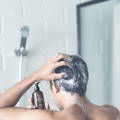
Edmund Ip
Flawless Tresses:
Mastering the Art of Hair Washing in 5 Simple Steps
Though seemingly simple, shampooing requires attention to various details, such as selecting the appropriate shampoo, ensuring the right temperature, and utilizing an appropriate lathering method. These techniques may impact the growth of scalp hair over time, particularly when coupled with common hair problems. By implementing these tactics, you can achieve not only more beautiful hair but also a healthier scalp.

1)Select the appropriate shampoo that suits your scalp
Selecting a shampoo that is best suited for your scalp condition is crucial, rather than choosing based on your hair quality. This is particularly important for girls with long hair as the tips are more susceptible to dryness and split ends. For those with oily scalps, opting for a moisturizing shampoo may exacerbate the oiliness. A more refreshing shampoo can reduce the scalp's burden while conditioner and hair oil can be used to enhance the moisture of the hair's ends.
"Though seemingly simple, shampooing requires attention to various details..."
2) Water temperature can affect the overall health and appearance of your hair
The sensation of hot water flowing down from your head to your body can be an exquisite pleasure, particularly during the winter months. However, washing your hair with hot water can have negative effects such as removing too much oil from the scalp, which can lead to dandruff, an oily scalp, and other issues. Instead, it's recommended to wash your hair with lukewarm water (36°C - 38°C), which is gentle enough to cleanse oil and dirt without causing damage to the hair or scalp. If weather conditions permit, consider using cold water for the final rinse to close the hair scales and protect the scalp follicles, which can prevent frizz and promote a shiny appearance.
3)Rinse your hair thoroughly for at least one minute before applying shampoo
Often, people may shampoo their hair when it is just slightly damp without realizing that it is not the most efficient method of cleansing. Actually, the initial rinse not only wets the hair but also initiates the cleansing process. To properly remove the dust and grease accumulated on the scalp, it is recommended to rinse the hair with warm water for at least a minute. This practice not only reduces the amount of shampoo required but also minimizes irritation to the scalp.

4)Always lather the shampoo in the palms of your hands
To ensure gentle cleansing and avoid scalp irritation, it is recommended to avoid applying shampoo directly on the scalp as the concentrated cleaning ingredients can be harsh. Instead, it is advisable to foam the shampoo in your palm and then apply it on the scalp with gentle pressure. This method not only offers convenience but also promotes healthy hair and scalp.
5)Blow-dry your hair following a wash
When hair is washed, the hair scales on the scalp open up and the hair cuticle becomes delicate and susceptible to damage. If you sleep with damp hair, the friction from the pillow can thin and dry out the cuticle layer. Keeping the hair wet for an extended period can also lead to headaches and migraines. To prevent such damage, it is advisable to dry hair with a hair dryer immediately after washing. It is also recommended to alternate between hot and cold air during the blow-drying process to avoid harming the hair and scalp with excessive heat.

